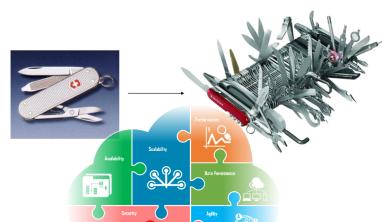Here are the top 21 digital transformation strategies recommended by businessmen and company executives who have successfully overcome the challenges of digital transformation and the pains associated with it. It will help you come up with creative solutions to level up your business in this digital age.
1. Leverage effective digital technologies that people really want
 Invest, leverage and use digital technologies that are proven to be effective and efficient. It brings your company, brand and business closer to people. Finding the right digital technologies is a must as it will pave the way for you to attract the attention of potential customers and clients who are willing to use your company’s new platform and improved digital technology.
Invest, leverage and use digital technologies that are proven to be effective and efficient. It brings your company, brand and business closer to people. Finding the right digital technologies is a must as it will pave the way for you to attract the attention of potential customers and clients who are willing to use your company’s new platform and improved digital technology.
Why leverage this kind of digital technology? The common answers are to build value and improve efficiency on the business models. You need to prioritize strategies empowering all these digital technologies. You need to know what their uses could be, understand their functions, and take advantage of the big data and information you collate. Doing so can boost the product or service quality as well as work productivity.
Practical Tips
Tip 1. Make Use of a Project Management Tool
Choose a time management tool that will help your team be more productive and cooperative. You will then be able to invest your time and efforts wisely. Examples of project management tools are: Trello, Asana, and Wrike. These three are the best and will help you and your team enhance productivity.
Tip 2. Use a Time Tracking Tool
Use tools such as Tick, TimeCamp, HubStaff, Harvest, and Toogi. These assist in measuring each member’s performance in relation to their assigned tasks. It gives them an insight on how they perform.
Tip 3. Use Social Media Management Tools
Use Automated digital tools such as Sprout Social, Hubspot’s Social Tool, Buffer, and Hootsuite. Save more time by using social media marketing tools for your business. You will be able to create content in advance and schedule them in simultaneously.
2. Improve cybersecurity of E-commerce systems & financial technologies
 Security is often considered important but not taken as a priority. This could lead to breaches in the system. Given that the digital world is vast, many viruses and cyber incidents are likely to happen and this is something that a CIO or executive cannot ignore.
Security is often considered important but not taken as a priority. This could lead to breaches in the system. Given that the digital world is vast, many viruses and cyber incidents are likely to happen and this is something that a CIO or executive cannot ignore.
Blake Angove, director of technology recruiting services at LaSalle Network cited that a likely reason these security problems are prevalent in some business systems is because of hesitancy to hire Chief Information Security Officers (CISO). Make sure all information and data within the company are kept and secured properly. You wouldn’t want a security breach which disrupts a number of your business operations.
Practical Tips
Tip 1. Change Your Passwords Every Month
Teach your employees to change their passwords. Make sure they know how to create strong passwords. Remind your team to turn this into a habit. To further strengthen your security, you can also utilize the Dashlane software.
Tip 2. Ensure That All Connections Have VPNs
Implement Virtual Private Networks (VPN) connections between your office locations. These protect your network, especially if you are connected through public Wi-Fi services. Make sure that all your connections are secured by VPNs.
Tip 3. Install Google Chrome’s Ad Blocker in Your Computer’s Browser
Implement Ad Blocker, which can be installed as a trusted cybersecurity feature in your internet browser, protecting you as you browse the internet. The chance of bugs entering your computers will significantly decrease if there is something that automatically blocks ads.
Tip 4. All Your Corporate Email Accounts Should Use Two Factor Authentication (2FA)
Use Two Factor Authentication such as Authy or Google Authenticator; it will help prevent hacking incidents, as there will inevitably be attempts from others to log into work emails to get hold of sensitive information.
3. Increase budget for research and development of digital transformation systems
There is no reason to hold back on expending capital for research and development of systems that can drive further success. According to the research of PwC in 2015, 45% of executives around the globe surveyed expect that their revenues will grow within the next five years after adapting to the digital transformation. And this of course needs capitalization.
Technology will not become an effective tool if one does not explore how it could be made better and contribute to the well-being of the whole company. Research and development enables IT systems to be properly maximized and optimized. Discoveries and innovation may be witnessed in the process. Research and Development is an excellent way to leverage your technology and your business to a higher level. Investing in these projects is constructive to the whole business operation.
Practical tips:
Tip 1. Let the R&D Decide on Go-To Market Options
Trust your team to make decisions by themselves and open potential opportunities, especially if they are aware of the market’s performance. When they know what they are up against, they become more motivated and encouraged to do better.
Tip 2. Encourage Everyone to Cooperate in R&D
Make sure that all team members are involved in stages of research and development. This includes working closely with other teams and the other business operations. As a team, you ought to share the same culture, strive to maintain high-quality products so that in return, the whole team’s motivation and overall efficiency is improved.
4. Hire competitive talents that will fit the current skill requirements
Being a CIO or a business executive is not just a position. Executives must embrace combining competitive skills and talents throughout the enterprise. In hot IT areas such as data science, dev-ops, and UX, the right competent talents are hard to scout out. Nevertheless, you may consider offering webcam interviews, posting jobs on social media, and maybe even learning some of the best methods on mining LinkedIn connections in order to look for prospective employees.
The digital revolution has the promise of a flexible and enhanced digital vision, which you can put to advantageous use. You may opt to use this digital vision in hiring employees from all other departments, and thus matching the right people with the right jobs would be much accurate and better in the long run.
Practical Tip
Host A Contest Or A Brainstorming Competition That Will Help Provide Effective Solutions
Sponsor a small contest for your IT candidates to come up with solutions for your anticipated problems in the company. Challenge them to “hack” and present their ideas by defending them in the most creative and convincing ways. This not only provides you with valuable solutions, but it also points out the best candidates for you to hire.
5. Develop user-friendly digital systems
A digital system is built to support and perform daily tasks and functions that machines could do to lessen the struggles of the human workforce. It also allows for more output in less time. Make sure that digital systems meet certain qualifications that make them user-friendly. In other words – ensure that the purpose of having digital technology is justified.
The systems should be efficient, easy to navigate, easy to install and remove, easy to operate, without the need of third-party software, effective in handling errors, and should abide by set standards. Do not underestimate the importance of the user-friendliness of the systems.
Practical Tip
Check If It Is Easy To Install, Update And Simple To Remove
Ensure easy installation, update, and removal. Whether the new digital system is an operating system or a single-client user application, always make sure that it is simple, clear, and documented. The software should also be easy to uninstall or remove.
6. Use data analytics to improve current digital systems implemented by businesses
Cloud and data analytics can perform many tasks for the entire business. Analytics can extract patterns and witness trends from big data inputted in to the system. Stitching the myriads of meaningful data together, and having them collated and analyzed by a computing system, can bring your business to higher levels of success.
Data analytics allow you to answer every day corporate queries such as, “What are the products that customers are buying?” “What is the audience talking about?” or “What is lacking in the computer systems?” Analysis of big data means being able to answer complex queries effectively so that your business runs more efficiently.
Practical Tip
Gather Information About Customers And Clients Through Facebook Analytics
When you use Facebook to market products, Facebook Analytics lets you focus on vital metrics. Other information that Facebook Analytics provides is gender and age demographics, and visitors’ locations. This data is useful for social media marketing, as it gives you an idea on where your general traffic comes from.
7. Convince members of the business organization to be open to digital transformation
According to 47% of the global executives surveyed by Progress in 2016, one of the greatest challenges of adapting to the digital transformation is the risk-averse culture in which we live. In order to address this, some solutions are needed. Word-of-mouth campaigns are sometimes not enough. Digital transformation must be embraced in corporate policies or emphasized in the core values of the company. You should be effective and efficient in persuading the resistant members of the business organization to openly embrace digital transformation.
The company culture will always resist new digital disruption and technology. However, gradually encouraging people to adopt the benefits and advantages of these digital technologies can allow the entire community of workers and even customers to adjust to the new technology. The business will operate effectively if this evolution of technology is supported rather than rejected or completely ignored.
Source: www.imd.org






